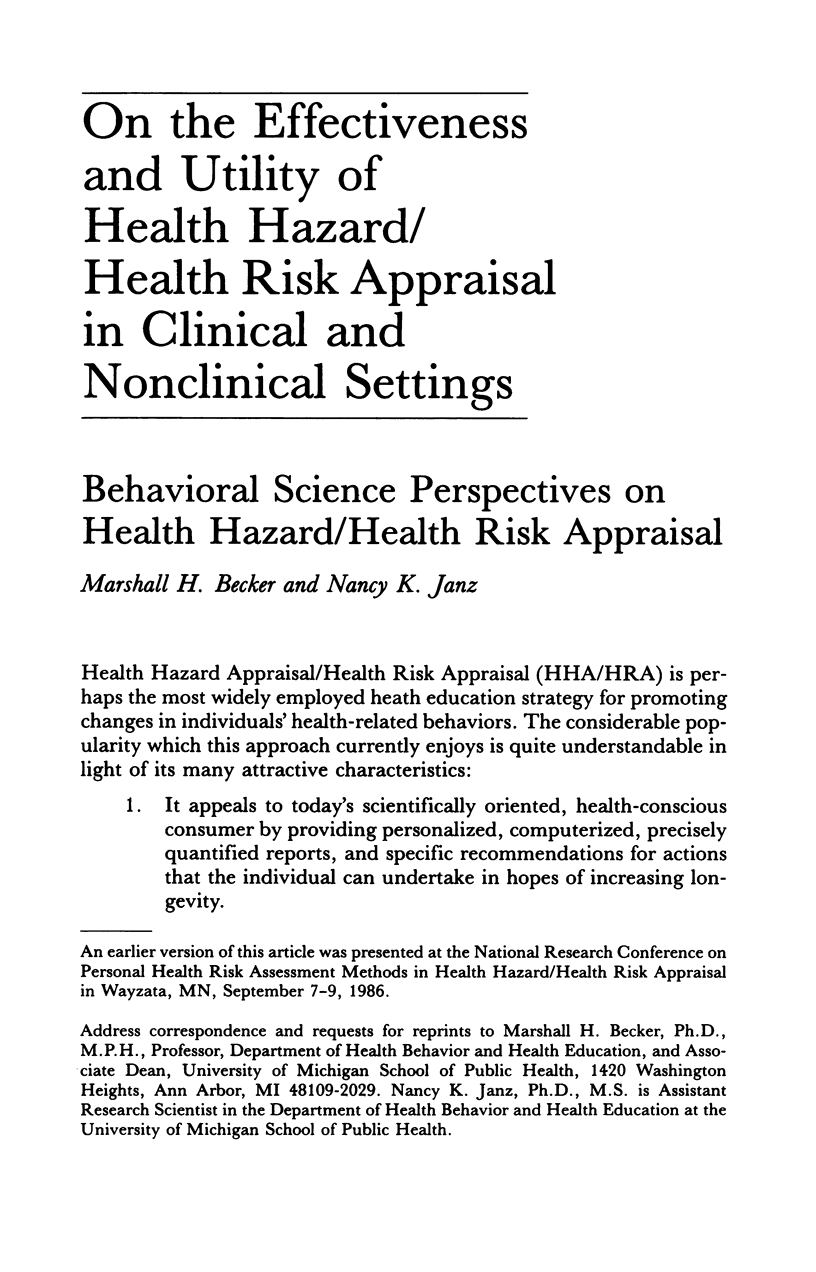Abstract
Health-promotion efforts often employ HRA as a device for providing an individual with quantitative information about the consequences of personal health-related behaviors and as an attempt to motivate the client to adopt recommendations directed at establishing a healthier lifestyle. From a behavioral science perspective, the HRA approach and process contain elements that (at least in retrospective analysis) appear to be founded in relevant bodies of theory. First, HRA seems to be a reasonably efficient mechanism for transmitting information relative to associations between personal health behaviors and mortality risks. Moreover, while general knowledge and advice about the untoward consequences of risk factors (such as smoking, obesity, high blood pressure, etc.) are currently widespread, HRA provides new and specific information: the client's own relative risks. Some individuals who voluntarily participate in HRA bring to the experience an already high level of readiness to take action; for them, the technique may constitute the final necessary stimulus or "cue to action" [12]. Referring to a "borrowing from the future" phenomenon, Green points out that "some educational efforts are really only triggers to behavior that would have changed eventually anyway" [44, p. 159]. Thus, where motivation is sufficiently high, receipt of HRA feedback information may by itself be capable of inducing behavior change. Second, the focus on awareness and personalization of mortality risk fits well with most theoretical formulations concerning attitudes and beliefs involved in health-related decision making. Although the emphasis on mortality and often distant negative outcomes is problematic, increasing the client's perception of personal vulnerability is a psychologically defensible approach, and fear arousal can generate attitude change (although questions of appropriate level, duration of effects obtained, acceptability, etc. still need to be resolved). Third, HRA might be expected to enhance the client's perception of the benefits associated with lifestyle modifications and may even increase personal belief in his or her ability to undertake such changes in behavior. However, in light of the fact that the behaviors to be altered are complex, usually well-established and repetitive, and require different skills to extinguish, the provision of typical HRA feedback should not (on a theoretical basis) ordinarily be expected to accomplish much beyond information transmission, belief or attitude change, and the induction of some level of motivation.(ABSTRACT TRUNCATED AT 400 WORDS)
Full text
PDF














Selected References
These references are in PubMed. This may not be the complete list of references from this article.
- Bandura A. Self-efficacy: toward a unifying theory of behavioral change. Psychol Rev. 1977 Mar;84(2):191–215. doi: 10.1037//0033-295x.84.2.191. [DOI] [PubMed] [Google Scholar]
- Becker M. H., Haefner D. P., Kasl S. V., Kirscht J. P., Maiman L. A., Rosenstock I. M. Selected psychosocial models and correlates of individual health-related behaviors. Med Care. 1977 May;15(5 Suppl):27–46. doi: 10.1097/00005650-197705001-00005. [DOI] [PubMed] [Google Scholar]
- Becker M. H. Patient adherence to prescribed therapies. Med Care. 1985 May;23(5):539–555. doi: 10.1097/00005650-198505000-00014. [DOI] [PubMed] [Google Scholar]
- Cummings K. M., Becker M. H., Maile M. C. Bringing the models together: an empirical approach to combining variables used to explain health actions. J Behav Med. 1980 Jun;3(2):123–145. doi: 10.1007/BF00844986. [DOI] [PubMed] [Google Scholar]
- Fabrega H., Jr Toward a model of illness behavior. Med Care. 1973 Nov-Dec;11(6):470–484. doi: 10.1097/00005650-197311000-00002. [DOI] [PubMed] [Google Scholar]
- Green L. W. Evaluation and measurement: some dilemmas for health education. Am J Public Health. 1977 Feb;67(2):155–161. doi: 10.2105/ajph.67.2.155. [DOI] [PMC free article] [PubMed] [Google Scholar]
- Hochbaum G. M. An alternate approach to health education. Health Values. 1979 Jul-Aug;3(4):197–201. [PubMed] [Google Scholar]
- Janz N. K., Becker M. H. The Health Belief Model: a decade later. Health Educ Q. 1984 Spring;11(1):1–47. doi: 10.1177/109019818401100101. [DOI] [PubMed] [Google Scholar]
- Kasl S. V., Cobb S. Health behavior, illness behavior, and sick role behavior. I. Health and illness behavior. Arch Environ Health. 1966 Feb;12(2):246–266. doi: 10.1080/00039896.1966.10664365. [DOI] [PubMed] [Google Scholar]
- Langlie J. K. Social networks, health beliefs, and preventive health behavior. J Health Soc Behav. 1977 Sep;18(3):244–260. [PubMed] [Google Scholar]
- Leventhal H. Changing attitudes and habits to reduce risk factors in chronic disease. Am J Cardiol. 1973 May;31(5):571–580. doi: 10.1016/0002-9149(73)90324-x. [DOI] [PubMed] [Google Scholar]
- Leventhal H. Fear communications in the acceptance of preventive health practices. Bull N Y Acad Med. 1965 Nov;41(11):1144–1168. [PMC free article] [PubMed] [Google Scholar]
- Mason J. O., Ogden H. G., Berreth D. A., Martin L. Y. Interpreting risks to the public. Am J Prev Med. 1986 May-Jun;2(3):133–139. [PubMed] [Google Scholar]
- Milio N. A framework for prevention: changing health-damaging to health-generating life patterns. Am J Public Health. 1976 May;66(5):435–439. doi: 10.2105/ajph.66.5.435. [DOI] [PMC free article] [PubMed] [Google Scholar]
- Strecher V. J., DeVellis B. M., Becker M. H., Rosenstock I. M. The role of self-efficacy in achieving health behavior change. Health Educ Q. 1986 Spring;13(1):73–92. doi: 10.1177/109019818601300108. [DOI] [PubMed] [Google Scholar]
- Wagner E. H., Beery W. L., Schoenbach V. J., Graham R. M. An assessment of health hazard/health risk appraisal. Am J Public Health. 1982 Apr;72(4):347–352. doi: 10.2105/ajph.72.4.347. [DOI] [PMC free article] [PubMed] [Google Scholar]


